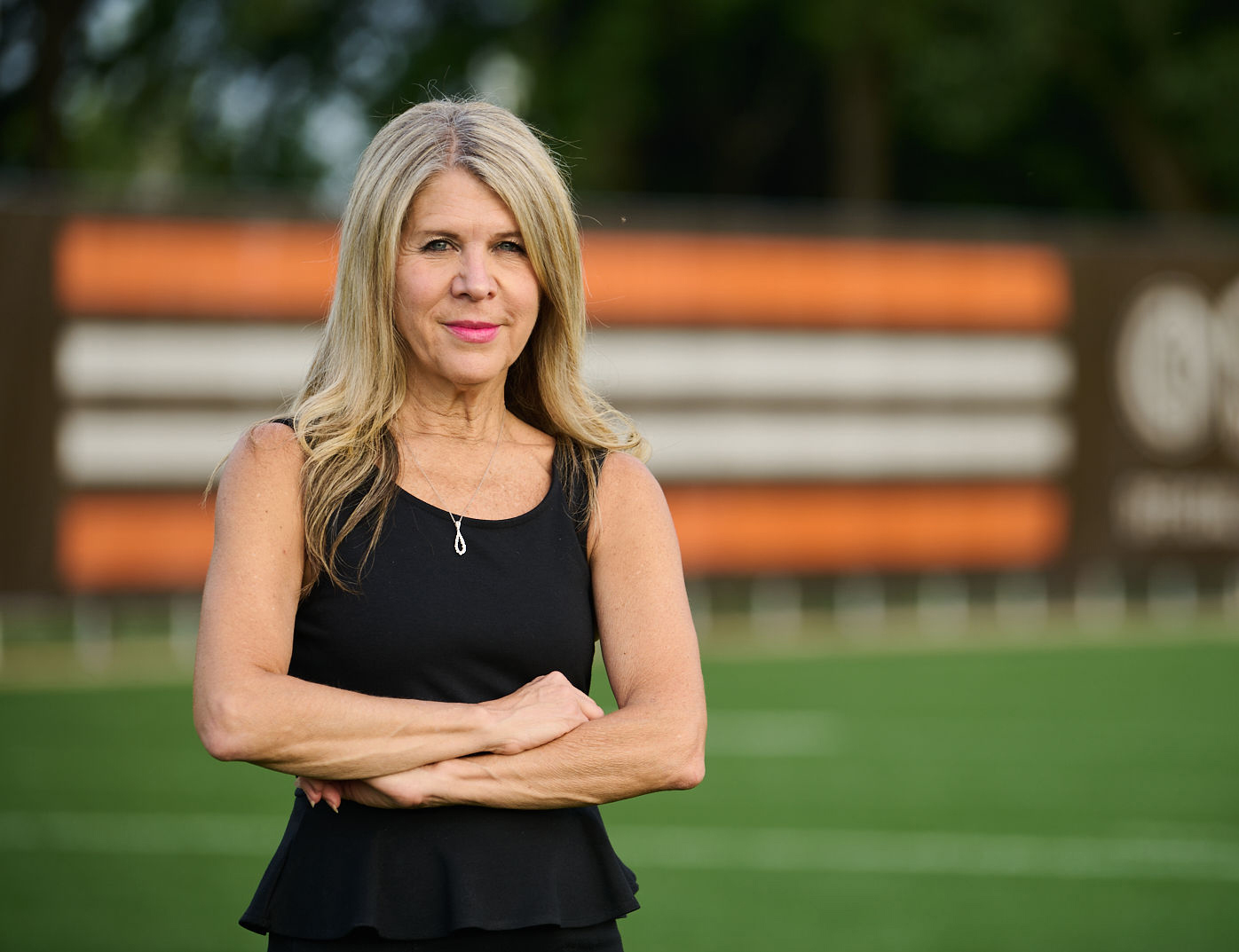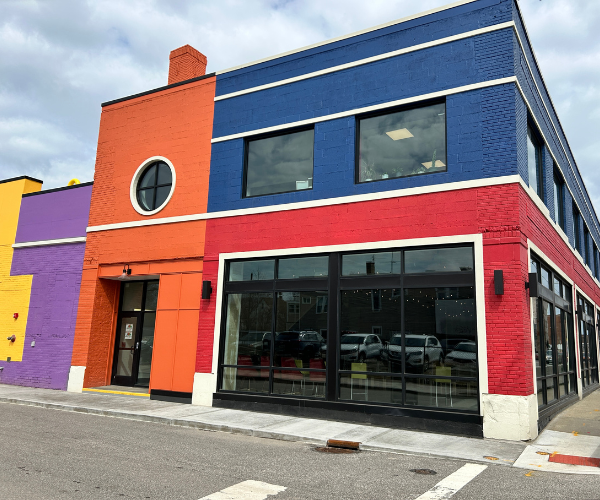Why Changes To The Plain Dealer Matter For Local Journalism
by Sheehan Hannan | Jul. 6, 2020 | 12:00 PM
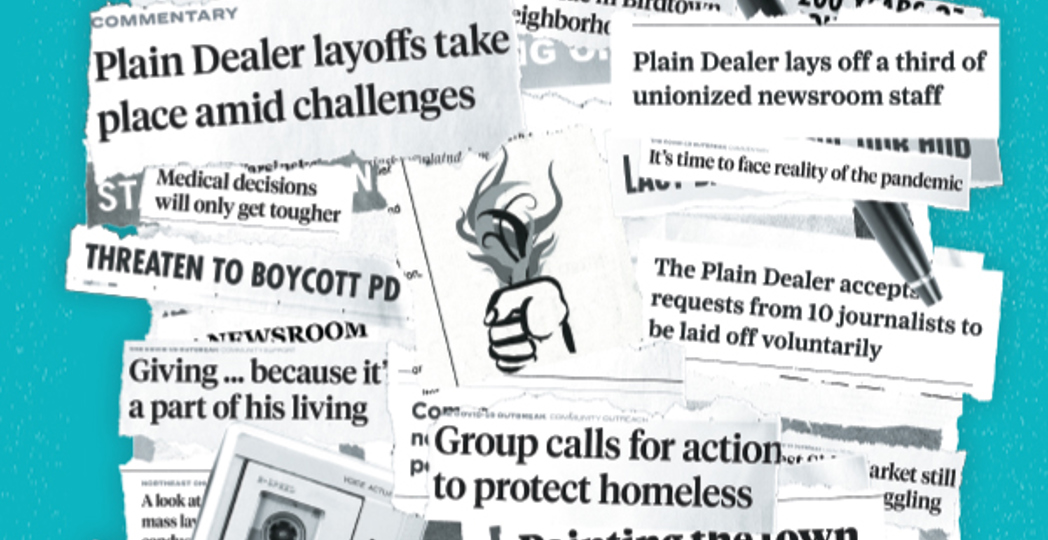
Ryan Grzybowski, Courtesy The Plain Dealer
One could feel the coursing and pumping of news in that place, the old Plain Dealer building at the corner of East 18th Street and Superior Avenue. When the vast presses revved to churn out the next day’s pages, they set the floors of the newsroom rumbling. Trucks waited at the loading docks out back to receive the papers. If they idled too long on Rockwell Avenue, they would spread fumes through the ducts and into the sports department. Back then, in 1982, this was an inky, stinky business that Tom Feran was in, and he couldn’t imagine it any other way.
When Feran arrived at his new job as the paper’s Sunday magazine editor, he found a newsroom bustling with some 400 staff and a vibrant union. Cleveland had just become a one-newspaper town — The Cleveland Press folded earlier that year — but The Plain Dealer had a circulation healthy enough to display on the editorial page: 405,842 daily and 448,219 on Sunday. The cafeteria fed night-shift reporters into the evening and just before 11 p.m., television newspeople lined up their cars along Superior to snatch the bulldog edition. “It was pretty huge,” Feran says. “That was the way you’d want a newspaper to be, in that building.”
Feran worked in that newsroom, and the ones that followed it — a building that replaced the old one at 1801 Superior Avenue in 2001, an office in Tower City, a room near the paper’s presses, this time in Brooklyn — for 37 years. He held most every job there at one point or another, from features editor to general assignment reporter to fact checker. He stayed there long enough to see the newsroom’s halcyon days and its downfall. He saw the dawning of the Internet age, and the cuts that inevitably followed: 27 laid off in 2008, a pay cut in 2009, more than 50 gone in 2013, buyouts in 2018. He saw the creation of Cleveland.com, a separate, nonunion newsroom. He saw the ranks of his colleagues grow thinner.
He had managed to survive culling after culling. But in early 2019, it became clear that, in addition to laying off 29 copy editors and layout designers, the paper was going to cut 14 newsroom positions. The paper’s average circulation figures that quarter were 171,404 on Sunday and 94,838 on Wednesdays and Fridays. Feran decided it was finally time for him to go. He had come to the newsroom after his 29th birthday. And after his 66th, he volunteered to leave it. “If I can go and save a job,” Feran told his editor. “I’ll do that.” The last story he filed as a staffer was about the layoffs.
He watched from retirement as several more rounds of layoffs this year wiped out the place where he had toiled for almost four decades.
All of the union reporters were laid off this April. Newsgathering operations at what is still Cleveland’s largest news organization — the conjoined twins of Cleveland.com and The Plain Dealer — were shifted entirely into the Cleveland.com newsroom, where about 65 nonunion staff work.
The move signaled the end of one era, and the maturity of another. The number of newspaper jobs, long the engine of journalism in Cleveland, has been falling for decades. The end of the union newsroom was a sign of their continued decline, and the dawn of a time dominated by digital-first newsgathering. That transition, in the offing for years, has now fully happened here, bringing with it a future where the business models are as-yet unproven and there are fewer reporters. Amid that uncertainty, a small but growing group of independent outlets have emerged to cover the stories that the giants have left behind.
Stuck between a constricting print business model and a shaky digital future, a time made even more unstable by the coronavirus, editors and reporters have been forced to scale back their ambitions. A careful reader can detect the gaps, the stories not told, the voices not heard. There is no one regularly examining the effect of money in city and county politics, writing daily obituaries, or covering the science and religion beats. The city where the river once caught fire has not one environmental reporter. Where Tamir Rice was killed, no one covers the confluence of race and policing full-time.
After the first-ever round of layoffs at The Plain Dealer in 2008, Feran gave a talk to a classroom of students at Case Western Reserve University. He recalls warning them that jobs tied to ink-and-pulp newspapers would become poorly compensated and stressful. And the future of local news gathering after newspapers, he opined prophetically, was deeply uncertain.
“It’s like death,” Feran told the students. “No one knows what’s on the other side.”

When Feran arrived at The Plain Dealer in 1982, it was a homecoming. He grew up in Mayfield Heights, in a family where the men were civil servants — firefighters, police officers, sheriffs’ deputies, surveyors. He ingested the mentality of local service so fully that at 8 years old, he founded a neighborhood newspaper. He wrote the stories and headlines, printed it on a toy printing set and distributed it on his block. “I just wanted it out there, so I didn’t even ask for money. Not even a nickel or a penny,” he says.
After his Sunday magazine stint, Feran worked for three years as the paper’s features editor, and then, as the 1990s dawned, as a television critic, a post he held until 2001. Being a TV critic in those days meant making a biannual trek to Los Angeles for a press tour, a rush of studio tours, celebrity interviews and screenings that sometimes stretched to three weeks, all on the newspaper’s ample dime. He also covered the comings and goings of various personalities on Cleveland’s TV news shows, and the stations’ merry-go-round ownership.
It could seem frivolous work to hard-news snobs, but readers relied on Feran to help decide which station to watch, and he took that responsibility seriously. He reviewed shows not based on his opinions, but on what he thought his readers would enjoy. He detested reality shows, for instance, but on March 2, 2004, he gave a positive review of Donald Trump’s The Apprentice.
A scan of that day’s paper shows the breadth of reporting the publication then included. Several stories were filed from Akron: one about a man freed from prison by new evidence and another on a woman who delivered sextuplets. An obituary detailed the life of a beloved Cleveland Heights nursing home administrator who died tragically of a heart attack, while a story from Lorain discussed why two women were angry over the closing of Lorain Catholic High School. A review of a Cleveland Orchestra Youth Orchestra performance was placed a few pages from a profile from Winter Haven, Florida, of a young pitcher trying to make the Indians roster. And there were reports from the frontlines of presidential candidates Dennis Kucinich, John Edwards and John Kerry’s swings through Ohio as Super Tuesday approached, one datelined from Columbus and another from Toledo.
The Plain Dealer had seemed on a glide path through the 1990s and early 2000s. But when the union’s contract came up in 2006, Feran could tell that it was in a far from rosy position. All he had to do was look at the classifieds, which came fewer and fewer every day. “If you wanted to know which newspaper was going to survive, you looked at the classified ad linage,” says Feran. “That stuff was like gravy. The one with the giant classified ad section was going to be the survivor.”
That year marked the point at which the nascent internet powerhouses began digging deeper into the veins of revenue that The Plain Dealer and other newspapers had long mined. Craigslist had been expanding into new markets for a decade, displacing lucrative classified advertising dollars from newspaper pages as it went. Google was purchasing YouTube for $1.65 billion, and would a year later acquire the display ad giant DoubleClick for almost twice that amount. Facebook was making itself accessible to anyone with an email address. Papers like The Plain Dealer were caught off guard, and many adapted slowly.
“There was some frustration and uncertainty how to proceed,” says Feran. “They were shifting things online, and it was not always wisely handled. But at that time, I don’t know if there was any paper that handled it well.”
The first round of buyouts for longtime veterans came in 2006. Another came in 2008, in the midst of the recession caused by the subprime mortgage crisis, followed by 27 layoffs. Columbia Journalism Review reported that those layoffs were the first in the history of the paper, and Feran recalls that the staff responded to them with more disappointment than anger. “I don’t remember fury,” he says. “There was just shock and amazement that this was happening, sort of ‘How has it come to this?’ ”
The union voted in favor of a pay cut a year later, saving 60 more people from being laid off, but by 2013 the bleeding had still not been stemmed. That year, The Plain Dealer announced it would deliver newspapers only three days a week. In the end, about a third of the paper’s editorial staff were laid off in 2013. There were other changes as well. Feran learned that another newsroom had been set up, down in the Flats. It was called Northeast Ohio Media Group, and it operated Cleveland.com, where reporters would publish content online for free before it appeared in the newspaper.
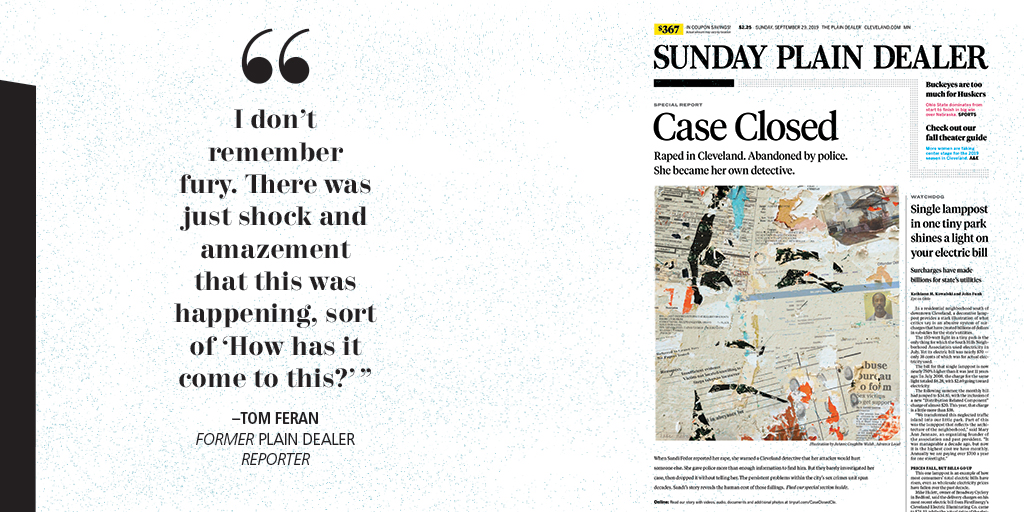
The layoffs didn’t stop.
Earlier this year, on March 9, The Plain Dealer News Guild announced that the paper planned to lay off 22 staffers, including 18 union employees and four nonunion managers. Even with the impending layoffs, The Plain Dealer reporters scrambled to cover the rising coronavirus crisis, filing stories about Ohio’s limited testing capacity and the effects of the shutdown.
“There was this sense that when you’re at your worst you do your best, and you show people, ‘Hey, we care about you guys first,’ ” says one reporter who worked through that period. (Those who were laid off have access to health insurance benefits until next February, as long as they signed a non-disparagement letter.) “And that’s what we did.”
Among those laid off April 3, in the midst of the story of the century, were some of the paper’s heaviest hitters. Brie Zeltner, a health care reporter, was instrumental in coverage of infant mortality and lead poisoning. Her final story for the paper — co-bylined with Rachel Dissell and Ginger Christ and posted on the day she was laid off — traced the past stigmas against the gay and Asian communities that the coronavirus had revived.
Teresa Dixon Murray was the paper’s always-vigilant consumer watchdog, tracking down answers to reader problems both large and small, from informations on Verizon’s data-usage policies to ways to get deferrals on credit card payments if you are laid off.
Andrea Simakis, a theater reviewer and metro columnist, reviewed countless Northeast Ohio shows with a gimlet eye. With Dissell, she also wrote “Case Closed,” the serialized story of a grandmother who had to track down her own rapist, exposing the Cleveland police department’s inadequate funding of its sex crimes unit along the way. Days after Simakis was laid off, the series won a Dart Award, which are given to stories that highlight trauma with empathy.
The Monday following the layoffs, editor Tim Warsinskey told the 14 remaining union staffers that they would be taken off their beats and tasked with covering outlying counties: Lake, Lorain, Geauga, Medina and Portage. In a statement, the Guild said that the move would pull the paper’s most experienced reporters off subject areas in which they had accumulated years, and in some cases decades, of institutional knowledge. “It’s clear that the company doesn’t value the expertise of its veteran reporters, and it doesn’t think the community does either,” the union said.
In a column later in the week, Warsinskey announced that 10 Guild members had made personal decisions to voluntarily leave The Plain Dealer, a characterization that the union disputed in a Twitter thread, saying that the paper had put its members “in an impossible situation.” “It was The PD who decided to lay off union workers,” the union said.
Among the 10 were Dissell, whose reporting resulted in thousands of untested rape kits being tested; Greg Burnett, who assembled the Friday event listings that readers used to choose their weekend activities; Michelle Jarboe, who consistently broke news on the development beat; Christ, whose stories about Cleveland’s ever-growing hospital systems were indispensable for patients and professionals alike; and Patrick O’Donnell, who covered the education beat through the implementation of the Cleveland Plan and near-constant state-level policy upheavals.
In another column on May 12, Warsinskey announced that the union was dissolving, as was The Plain Dealer newsroom. The four remaining Plain Dealer reporters — travel editor Susan Glaser, architecture critic Steven Litt, general assignment reporter John Caniglia, and sports and faith columnist Terry Pluto — were laid off from their Plain Dealer jobs and offered positions at Cleveland.com. A fifth, Julie Washington, later joined them. The union bargaining unit officially dissolved on May 17.
“To those Guild members who came before us: We are sorry,” said a union statement. “To the city and people of Cleveland and Northeast Ohio: We will miss you. We did our best.”
The one-two-three punches of layoffs, followed by the decision to take reporters off their beats, followed by more layoffs, brought to the fore old charges that the two-newsroom structure was set up to bust the union.
Though the two newsrooms had supposedly been established so that one could pursue print while the other did digital, by the time the layoffs had come down, that difference had ceased to exist. Both The Plain Dealer and Cleveland.com reporters pursued the digital-first strategy of posting stories in real time as news happened on Cleveland.com. Those stories then appeared in The Plain Dealer. That the newsrooms were separate appeared to be a distinction without a difference.
Warsinskey has attributed the April layoffs to the financial challenges of the news business, writing in a column that, “these departures are emblematic of a larger challenge our industry is facing.” But the layoffs happening in one newsroom and not the other looked like union-busting, says Rick Edmonds, a Poynter Institute media business analyst who covers Advance Publications, which owns The Plain Dealer and Cleveland.com. “It amounted to a pretty clear move on the union,” Edmonds says.
Brad Harmon, regional Midwest president of Advance Local, says he was not involved in decisions about the layoffs. (Cleveland.com editor Chris Quinn, who was unavailable for comment by Cleveland Magazine’s deadline, said the same at a May Press Club of Cleveland event.) “But as I understand it, it was the Guild who first suggested that they walk away from The Plain Dealer. Five folks, Terry Pluto and others, joined the group [Cleveland.com], and the others decided to move on,” he says. “I wouldn’t say it’s union-busting. Everyone has their own terms. I would say that there was a decision folks made to walk away, so we made the best of it.”
Harmon, a Lake County native who first broke into the news business at 19 in 1982 with a circulation internship at The News-Herald, joined Advance Local in December 2019. (He is not related to the Harmon family, Cleveland Magazine’s owners.) Most recently, he was president and publisher of The Columbus Dispatch.
“Folks are looking at Cleveland and saying ‘Oh my gosh, it’s a news desert.’ No, we have over 65, close to 70 actually, journalists, photographers, videographers within the organization,” he says. “I came from Columbus. We have just as many staff as The Dispatch and Dispatch.com has.”
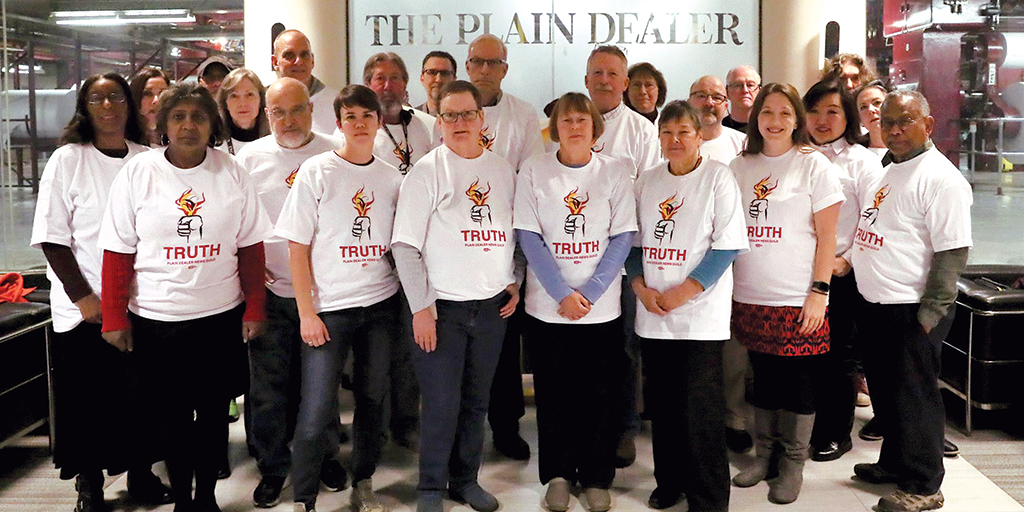
Chris Horne remembers the specific story that broke him. It was June 2014, and Horne was working as a social media producer at News 5 Cleveland. A Cleveland man, Derrice Alexander, got into an argument with his girlfriend, pulled out a gun and fired a shot, killing his 2-year-old son, Derrice Alexander Jr.
Horne watched News 5 Cleveland cover the story, and something in him cracked. He knew why his station, and all the other news outlets in Cleveland, were publishing stories about the horrific crime. It was news, and they were bound by their duties to viewers, readers and shareholders to report it. But Horne couldn’t understand why what led up to and followed the crime did not warrant the same attention. “Everybody did a story on it, but there was this impact on the community that wasn’t being measured at all. Nobody was going in there and talking about domestic violence or any of the conditions that would have led to this situation,” he says. “It was just exploiting it for traffic. And I got tired of being a part of that.”
So Horne quit, and in 2014 set up an alt-weekly magazine, The Devil Strip, in Akron. But the magazine could only get so far on advertising revenue alone. In 2019, Horne set in motion a plan for the first-ever community-owned news co-op in the nation.
The for-profit model of publications like The Plain Dealer or the Akron Beacon Journal, and even of stations like News 5 Cleveland, was leaving gaps in local news coverage, Horne realized. And even when the business side of those publications held to the tradition of not interfering with news coverage, its decisions inevitably shaped the way publications covered their communities. “If the goal of the business model is to make as much money for a hedge fund as possible before it all collapses, then it’s going to shape the journalism,” says Horne.
The co-op model, Horne thought, could serve the needs of the community directly by making community members its shareholders. “It’s literally not going to make anybody any money,” Horne says. “That’s the point of it, to take the profit motive out of the reporting.”
The model calls for The Devil’s Strip’s revenue to come almost entirely from readers, who are encouraged to become active participants in The Devil Strip’s governance. Content is offered for free online and in its printed publication, and readers support the magazine by purchasing memberships. The publication has also continued to sell ads and sponsorships. The memberships are set up on a sliding scale, from $11 to $144 a year, to make them accessible to the widest possible audience. Once a member pays a total of $330, they become a shareholder, which means they can run for a seat on The Devil Strip’s governing board themselves or cast a vote for a board member who supports their views. Shareholders get a say on issues such as the publication’s budget and coverage topics.
Horne considered the traditional nonprofit model, where money to pay for journalism would be raised from wealthy individuals, foundations and the public. But he found it imperfect. Fundraising is time-consuming and arduous. And to Horne, the nonprofit model would have replaced an inaccessible group of shareholders with an inaccessible group of donors. “The intentions are better,” says Horne. “But without that public input and participation, how do you know you’re not going to bend the editorial mission toward whatever the Knight Foundation wants, or whatever MacArthur [Foundation] wants or Ford [Foundation] wants, or whoever is giving you money?”
Initial costs for the co-op were covered by a $200,000 grant from the Knight Foundation, a $50,000 grant from the GAR Foundation and a $30,000 grant from the Membership Puzzle Project. Horne is grateful for those donations, but he sees them only as startup investments. He hopes the co-op will not be reliant on foundations for its funding in the future.
The Devil Strip currently has 11 staff members, including two Report for America fellows. Seven are full-time, including three reporters and an editor. They and a crew of freelancers cover a wide variety of stories, including the fallout from accusations of racism at the Akron Art Museum, one family’s experience with eviction, local Black Lives Matter protests and how Akron artists are taking performances online during the coronavirus.
The co-op launched in February, months after GateHouse Media, which owned the Akron Beacon Journal, purchased Gannett. So far, the co-op has more than 500 members. The Devil Strip has enough money on hand for about seven more months of operations at its current level, says Horne. If it were to reach about 3,000 members, the publication would be able to pay its bills on memberships alone. “I wanted something that would give Akronites a little skin in the game,” says Horne. “It’s not just our financial longevity that’s at stake with the co-op. Their participation shapes whether or not we’re a good publication.”
There are far fewer reporters in Cleveland than there once were.
In the early 1980s, The Plain Dealer alone employed about 400 newsroom staffers, including reporters, editors, layout artists, illustrators and cartoonists. That number stood at more than 300 well into the mid-1990s.
Between Cleveland Magazine, Cleveland Scene, Cleveland.com, Cleveland Jewish News and Crain’s Cleveland Business, there are just over 100 editorial staffers working in Cleveland today. Fewer than that are full-time reporters. If one includes in that estimate traditional print publications such as the Medina Gazette and Lorain’s The Morning Journal, regional sites such as Belt Magazine and the small community of frequent freelancers, there are perhaps 200 editorial employees dealing primarily in the written word in various capacities. They serve a region of more than 2 million people and, even combined, their number pales in comparison to what The Plain Dealer once had alone.
Those reductions are tied to the shrinking paper medium. Between 2004 and 2017, Ohio lost 60% of its newspaper industry jobs, according to a report by the local think tank Policy Matters Ohio. Cuyahoga County experienced the sharpest decline of overall newspaper jobs in the state, losing 80% in that time. The number of newsroom employees experienced a similarly precipitous decline between 2012 and 2018 in the state, dropping by nearly 43%. “That’s a huge amount,” says Caitlin Johnson, one of the report’s authors.
Even winnowed by a still-sliding print subscriber count, Cleveland’s largest employer of reporters remains the Cleveland.com/Plain Dealer monolith. Advance Local is a private company and does not disclose specific figures, but Harmon says that a “decent portion” of its revenue still comes from print.
Harmon expects print subscriptions to plateau. The strategy Cleveland.com uses to pay its bills instead is to offer stories for free online to run up large traffic numbers, against which ads can be sold. And traffic has, indeed, grown. In May, Cleveland.com pulled in 9.9 million hits and 4 million unique visitors. A story about the resignation of Ohio health director Dr. Amy Acton in June netted 540,000 views alone, says Harmon.
But after offering a free lunch since 2013, this spring, Cleveland.com learned the value of portion control. Advance Ohio is not abandoning the advertising-supported digital model, but, in the midst of the coronavirus downturn, it started to solicit voluntary digital-only subscriptions from Cleveland.com readers. About 1,400 people subscribed, says Harmon. Quinn also announced on Cleveland.com that starting in July some of the site’s stories will be labeled “exclusive” and be accessible only to people with Cleveland.com accounts. Exclusive stories will eventually be put behind a subscriber-only paywall, though Quinn wrote that “90%” of the site’s stories will remain free. (Harmon is unsure yet what proportion of stories will eventually be paywalled.)
With fewer reporters working in Cleveland, the quality of individual stories is not lost so much as the scale of coverage. There are still many excellent reporters working at places such as Cleveland.com, investigating wrongdoing and holding public officials accountable. But when there are fewer of them, says Poynter’s Edmonds, important subject areas, such as education, get less attention. “A lot is gone,” says Edmonds. “Sometimes investigative reporting is something they keep, but you lose a lot of people at meetings, keeping an eye on what’s going on.”
Cleveland.com will be beefing up its coverage of areas such as education and health care soon, Harmon says, though he said additional staff will not be hired. “In the next several months, we’re going to start focusing on certain categories that are very, very important to the community at large that we haven’t done as good a job as we could have in the recent past,” Harmon says.
Policy Matters, in its report, pointed out the ways that reduced local news coverage impacts cities like Cleveland. Studies show that less coverage of local politics correlates with lower voter participation, especially in midterm years, and tends to favor the incumbent. When newspapers shut down, municipal borrowing costs go up. And epidemiologists often use local news reports to track the spread of viruses. With fewer reporters, those reports lose their impact. “A lot of times you think of newspapers as the Fourth Estate, the watchdog, important for democracy. And it is of course,” says Johnson. “But there’s much more to it.”
If there is a positive from such a decline of Cleveland’s mainstream media, it is that it has recently fostered a culture of experimentation in niche media. Neighborhood Connections is launching a one-year pilot program to pay locals $16 an hour to document local public meetings in partnership with Chicago-based City Bureau. Ken Schneck, a Cleveland Magazine freelancer, recently launched The Buckeye Flame, which covers the LGBTQ community statewide. The Cleveland Review of Books, established in 2018, gives writers a chance to critique art, books and more. And freelancer Lee Chilcote and former Freshwater Cleveland publisher Tammy Wise have launched The Land, a news startup that covers Cleveland’s neighborhoods and inner ring suburbs. A group of former Plain Dealer reporters, including Dissell, have also begun to investigate the possibility of creating a new nonprofit reporting and civic engagement outfit.
For Horne, he hopes his co-op model will spur a structural change in Northeast Ohio, one that divorces publications from their uncertain business models and joins them at the hip with the communities they serve. “Can you do it?” he says. “Yeah. It just means thinking very differently about what a newsroom is.”
Feran, for his part, is resigned to the further decline of newspapering. He is semi-retired, but is also an admirer of the historian Robert Caro, who has continued doing journalism into his mid-80s. So he continues to work. He recently finished co-writing a book. The House That Rock Built, which tells the story of the creation of the Rock & Roll Hall of Fame, comes out in September.
There are still moments since he was laid off from The Plain Dealer when he finds himself reaching for his phone — seeing a story that needs reporting. Then he will pause.
“The trouble is, I don’t know who to call in [to],” Feran says, “or there’s nobody to call anymore.”
Trending
-
1
-
2
-
3
-
4
-
5




